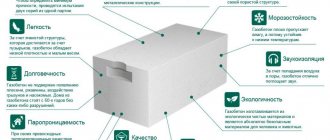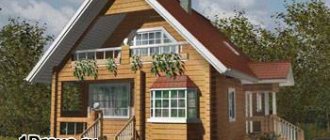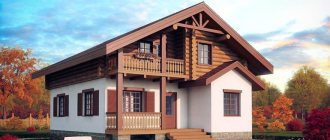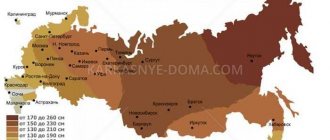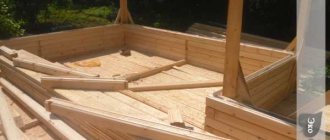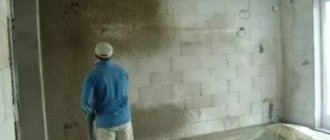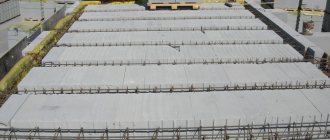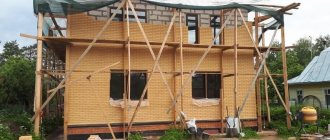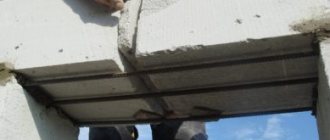Frame structures and blocks made of cellular concrete (aerated concrete, foam blocks) are considered the most economical, fast and popular methods of building houses. Each technology has not only its advantages, but also some disadvantages.
What is better: a frame house or one made of aerated concrete or foam blocks? Only by comparing their features can you make a decision regarding the choice of one material or another and not regret it in the future.
Description
Frame
A frame house, as the name implies, is built on the principle of creating a special box, which is subsequently insulated and sheathed with wood or other material.
Often the frames are made of wood, but there may be others:
- frame-panel structures;
- metal frame buildings;
- frame buildings with an increased level of insulation, which are erected using laminated veneer lumber.
Structure made of cellular concrete (aerated concrete and foam blocks)
In private construction, aerated and foam concrete is quite popular due to its increased thermal insulation properties and relatively low weight. Thanks to this, it is possible to build walls much faster.
Houses made of cellular concrete are very light, but at the same time, the material has one unpleasant feature - it has a low level of fracture resistance.
Because of this, it is necessary to pay great attention to the base, because with the slightest movement, the wall can crack.
Block geometry
When producing both types of blocks, the geometry of each of them can differ radically
When producing both types of blocks, the geometry of each of them can differ radically. Thus, aerated concrete is fully controlled during the production process and is manufactured in accordance with GOST. Hence, the maximum possible deviations in the thickness, height, width and length of the block range from 1 to 5 mm. Thus, aerated concrete is considered more even in relation to the foam block.
In turn, the foam block is cut during production without complying with standards, which leads to significant distortions of the walls of the material. Laying such blocks entails certain delays during the construction of a house:
- Thus, a house made of uneven foam blocks will subsequently have to be leveled both along the outer and inner walls;
- Laying non-geometric foam blocks requires greater consumption of construction/adhesive mixtures, which increases the amount of construction costs even at a relatively lower cost of the material;
- In addition, the uneven sides of the foam block threaten the formation of large cold bridges, which in turn will affect the microclimate in the finished house.
Important: and at the same time, it is worth remembering that foam and gas blocks have different levels of shrinkage when the masonry dries, which will also entail a change in the structure of the masonry. For example, when drying, aerated concrete shrinks by only 0.5 mm/m, while foam concrete shrinks by 1-3 mm/m.
Comparison
When comparing, it is important to take into account as many factors and indicators of one and another material as possible. It is very important to consider not only cost, but even environmental properties .
It wouldn’t hurt to take into account the terrain and weather conditions that prevail in the region, but it’s worth starting with the most important thing – determining the cost of materials.
Which is cheaper?
This is one of the key questions for most people who cannot decide on the choice of material. It is quite problematic to answer this question unambiguously, because it is necessary to take into account several construction issues that will ultimately affect the final cost.
It is not enough to compare materials alone, because construction begins with the foundation. For both options, a pile-grillage foundation will be optimal, but the cost in different cases will not be the same.
Due to the fact that the thickness of the concrete block walls is greater, the grillage must be wider, which will increase its cost by up to 40%.
The cost of building materials will also differ , even though no special lifting equipment is required.
A box made of concrete blocks will be on average 35% more expensive. This is due not only to the higher cost of the material, but also to the need to reinforce window openings and masonry.
For other parameters, including: utility networks, interior and exterior decoration, roofing work, the technologies will be approximately equal in cost. As for the cost, a frame house will certainly be cheaper, but other nuances must be taken into account.
Which one is warmer?
It is very important (especially for the cold regions of our vast country) to take into account thermal insulation properties . Cellular concrete has a porous structure.
The proportion of air in it is at the level of 75%, and air is a good heat insulator. To withstand winter cold, the thickness of the walls should not be less than 400 mm.
It is also necessary to take into account the possible presence of water in the blocks, which will significantly reduce the thermal insulation properties, therefore it is additionally necessary to use a layer of insulation of at least 50 mm, for example mineral wool.
In order for a frame house to have the same thermal insulation properties as a house made of cellular concrete with a wall thickness of 40 cm and 5 cm of insulation, it is necessary to insulate the frame wall with a layer of mineral wool at least 150 mm thick with additional layers of a vapor barrier (wind-moisture-proof membrane).
In other words,
both houses can be warm enough (of course, subject to the correct construction technology) .
The warmer option will be the one that uses more insulation. From the point of view of saving space, taking into account the decorative finish and ventilated gap, the thickness of the walls made of cellular concrete will be 490 mm, and the thickness of the frame walls will be 240 mm.
If we take a two-story house with an area of 140 square meters, then the loss of usable space in a block house will be 26 square meters.
In a house made of cellular blocks, temperature fluctuations will be less felt in the event of sudden weather changes or heating shutdowns.
Construction speed
It is necessary to take into account some other factors that will help you make your choice. It’s worth starting with the fact that many may be concerned about the speed of construction.
Frame technology will be the most appropriate in this case. A frame house can be erected in one season and you can move into it by winter. Moreover, you can immediately begin finishing, since there is no need to wait for such houses to shrink.
The aerated concrete version can be erected on average in 8 months, but the house shrinks slightly . One thing that can also be said in favor of these two technologies is the possibility of creating original architectural designs.
Other indicators
As for sound insulation, in this case the cellular block technology undoubtedly wins. Aerated concrete has a high level of vapor permeability, making it easier to maintain a comfortable indoor microclimate.
Manufacturers claim that block houses have a longer service life, up to 100 years .
But such statements are purely theoretical, because the same insulation, finishing and other materials have a shelf life that hardly reaches 50 years.
Material quality
In the production of both types of blocks (foam concrete or aerated concrete), different production capacities are used, which directly affects the quality of the building material
In the production of both types of blocks (foam concrete or aerated concrete), different production capacities are used, which directly affects the quality of the building material. Thus, foam concrete does not require powerful equipment for making blocks. It can be produced in small enterprises without significant capital investment. Hence the wide popularity of foam block production as a type of business activity. The disadvantage of this approach to the production of building materials is insufficient quality control of the blocks and possible non-compliance with manufacturing technology. Therefore, when buying foam blocks for building a house, you should at least select a trusted manufacturer.
The gas block, unlike its foam “brother,” is produced at large production enterprises that monitor the quality of the finished material, manufactured in accordance with GOST. Let us note that it is impossible to produce aerated concrete blocks in artisanal conditions, since the process requires constant and simultaneous control over several processes at once.
Houses made of brick or aerated concrete: which is better to build?
Important: the process of producing gas blocks is automated by 95%, which makes the use of such equipment impractical for an average entrepreneur. That is why the buyer can be one hundred percent confident in the quality of the finished gas-block products, confirmed by the relevant documents (certificates, protocols, etc.).
Comparison table of characteristics
So, to summarize, it is necessary to briefly note the positive and negative aspects of using these two construction technologies:
| Characteristic properties | Frame or aerated concrete |
| Frost resistance | The cellular block and frame structure can withstand up to 150 cycles, but this fairly high figure can also be increased with technically correct construction work and subsequent operation of the building. |
| Self-construction without special lifting equipment | Both technologies have this possibility. Often there is no need even for a large team of workers. 5-8 people are enough for comfortable work. |
| Biological resistance | It is quite clear that the wooden frame loses on this point. To eliminate this drawback, it is necessary to additionally purchase special protective compounds and carefully go through them. As for the blocks, they are completely not susceptible to biological effects. Only conditions of absolute dampness and heat can provoke the appearance of mold or mildew. |
| Aesthetics | Again, it is impossible to say anything specifically, because everything directly depends on the personal preferences of the developer. Among other things, there are a huge number of modern finishing materials that allow you to achieve any appearance. |
| Environmental friendliness | Of course, wood is the most environmentally friendly material. In second place are cellular blocks, but they are still inferior to wood. |
| Fire resistance | Everything is simple here - a house made of a wooden frame can catch fire, which cannot be said about blocks, which are the most non-flammable material. |
| Variability of finishes | Both technologies offer the possibility of choosing a large number of finishing options to suit every taste. |
| Difficulty in working | Of course, it is necessary to have certain knowledge and skills when working with both materials, but in general, anyone can construct a building using such technologies. You don't have to put in any extra effort. |
| Construction speed | If the deadlines are quite tight, then frame technology will be the best option for construction. It is much faster starting from the first stage - laying the foundation. |
| Price | Many developers claim that frame construction is much cheaper, but it is necessary to understand that the final cost is formed not only based on the cost of the material itself. It is necessary to take into account finishing, insulation and a lot of other nuances. Taking into account all these factors, you can draw up the final shift and compare it with the second option, but if we talk specifically about the minimum cost, the frame option will actually be cheaper. |
| Heat exchange | It is not possible to unambiguously single out one of the presented construction structures based on this criterion. This is due to the fact that a lot depends not only on the thickness of the walls and the insulation method, but also on other factors. In fact, both buildings will have a high level of heat retention if the technology is carried out efficiently according to all the rules. |
Foam and aerated concrete: differences in production
Both types of blocks (aerated concrete or foam concrete) for building a house are a cellular material that is produced using an autoclave or non-autoclave method
Both types of blocks (aerated concrete or foam concrete) for building a house are a cellular material that is produced using an autoclave or non-autoclave method. The first involves hardening the material in molds under pressure above atmospheric pressure. In the second case, the blocks poured into molds harden under natural conditions.
A characteristic feature of both types of blocks is the presence of a large number of pores in the structure, which makes the blocks light and convenient for construction. This is where the similarity of the material ends.
Aerated concrete is a building block made from a mixture of lime, sand, gypsum, cement, water and a special admixture in the form of aluminum paste as a raw material for good gas formation. All ingredients are placed in a mixer, where they are thoroughly mixed. As a result of the chemical reaction of aluminum powder and all components, increased formation of hydrogen occurs, which fluffs up the mixture. This suspension is poured into the mold and left until preliminary hardening. After which the mixture is cut with metal strings into perfectly even blocks and dried by autoclave using high temperatures, pressure and steam. Ready-made aerated blocks have an almost ideal geometry, which simplifies the laying of house walls and makes the consumption of material and masonry mixture more economical.
In turn, foam concrete is made from a mixture of concrete and special chemicals that form foam when the components are mixed. In this case, reagents can be used of both organic and synthetic origin. In the latter case, foam concrete is a less environmentally friendly material in contrast to aerated concrete. The production of foam concrete involves pouring the resulting foam mixture into special molds and drying it under natural conditions. Finished foam blocks are released from the molds and used to build the walls of the house.
Important: the foam concrete mixture can be poured directly into the formwork, which makes the construction process more labor-intensive, but at the same time saves the consumption of building material.
